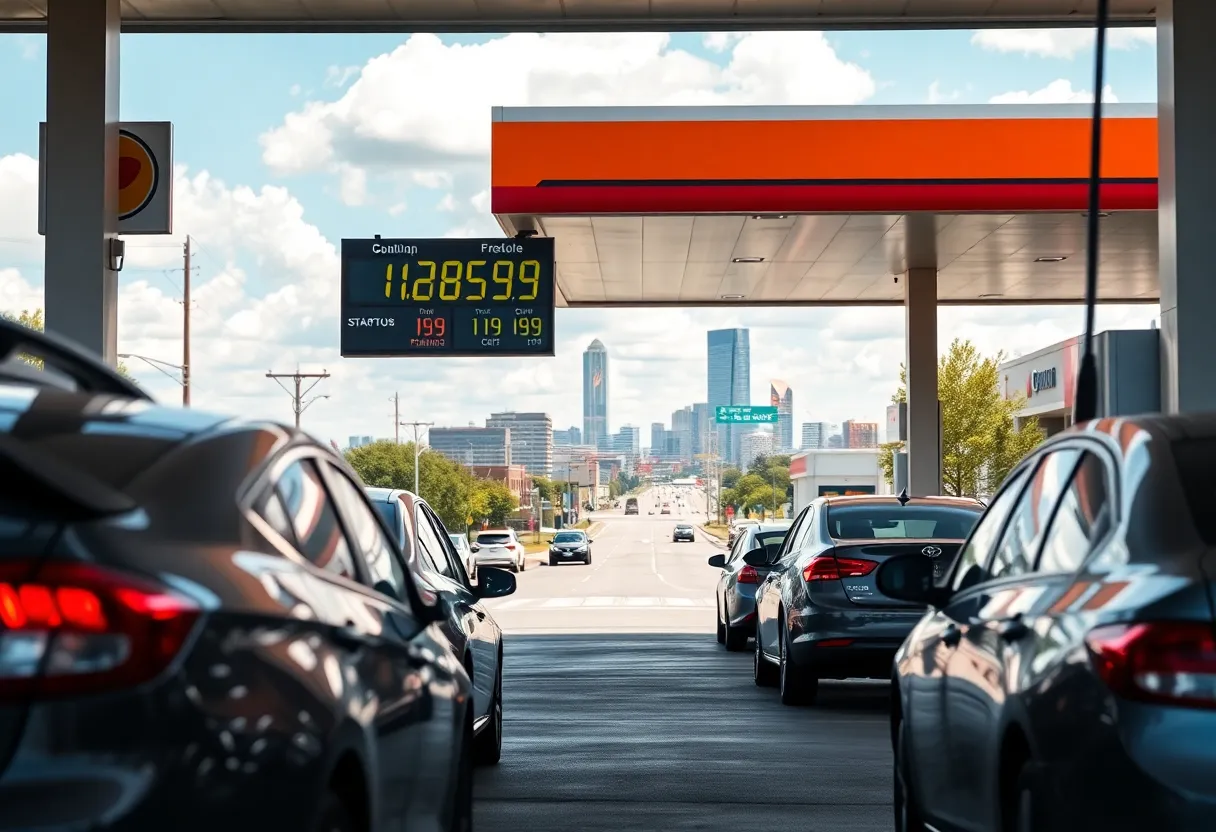Oklahoma City, October 14, 2025
Drivers in Oklahoma City are experiencing a small decrease in gas prices, with the average dropping to $2.89 per gallon this week. This 5-cent reduction comes amidst stable crude oil prices and seasonal demand shifts. While local stations are benefiting from increased traffic and sales due to lower costs, experts caution that geopolitical tensions could reverse this trend soon. The decline reflects broader trends in fuel pricing but may be short-lived as external factors continue to impact market stability.
Oklahoma City Gas Prices Dip Slightly Amid Stable Market Conditions
Oklahoma City drivers are benefiting from a small decrease in gas prices this week, with the average cost dropping to $2.89 per gallon as of Monday. This modest reduction of about 5 cents from last week’s rates comes amid stable crude oil prices and typical seasonal shifts in demand, offering some financial relief at the pump.
The decline reflects broader trends in fuel pricing influenced by steady supplies and reduced consumption patterns as fall weather settles in. Local stations have seen consistent customer traffic, with many residents taking advantage of the lower costs to fill up their vehicles. However, industry observers note that this trend could be short-lived, as ongoing geopolitical tensions in key oil-producing regions pose a risk of price volatility in the near future.
Factors Driving the Price Drop
Several elements are contributing to the current softening of gas prices in Oklahoma City. Primarily, crude oil markets have remained stable, avoiding the sharp fluctuations seen earlier in the year. This steadiness is partly due to consistent production levels from major suppliers and no major disruptions in global supply chains so far. Additionally, seasonal demand shifts are at play—colder temperatures and shorter days often lead to less driving for leisure, easing pressure on fuel reserves.
Station owners across the city report that the 5-cent dip has encouraged more frequent visits from commuters and families, helping maintain steady sales volumes. For a typical driver filling a 15-gallon tank, this translates to roughly 75 cents in savings per visit, a noticeable but not transformative amount for household budgets strained by other rising costs.
Potential Challenges Ahead
While the immediate outlook appears positive, experts caution that external factors could quickly alter the landscape. Geopolitical tensions, particularly in the Middle East and other oil-rich areas, have the potential to disrupt exports and drive up crude prices overnight. Past events, such as conflicts or sanctions, have led to rapid spikes at the pump, and current uncertainties mirror those risks.
Furthermore, domestic factors like refinery maintenance schedules and transportation logistics could influence local availability. Although Oklahoma’s robust energy sector provides some buffering, any nationwide ripple effects from supply constraints might still impact Oklahoma City prices. Drivers are advised to monitor updates closely, especially as holiday travel seasons approach, which could counteract the seasonal dip with increased demand.
Impact on Local Economy and Daily Life
The slight price reduction has subtle but real effects on everyday life in Oklahoma City. Commuters relying on personal vehicles for work or school see minor savings that can add up over time, potentially freeing up funds for other essentials like groceries or utilities. Businesses, particularly those in transportation and delivery, also benefit from lower operational costs, which might help stabilize prices for goods and services.
In a city where many residents drive long distances due to its sprawling layout, even small changes in fuel costs resonate widely. Neighborhood gas stations, from busy urban corners to suburban outposts, have noted busier lots without the overcrowding seen during peak summer months. This balanced activity supports local economies without overwhelming infrastructure.
Historical Context and Comparisons
Looking back, gas prices in Oklahoma City have fluctuated significantly over the past year. Last winter saw averages hover around $3.20 per gallon, driven by winter storms and supply chain hiccups. The current $2.89 rate marks a return to more affordable levels not seen since early spring, providing a welcome breather for consumers.
Compared to national averages, which stand at about $3.05 per gallon, Oklahoma remains competitive, thanks to its proximity to production hubs and pipeline networks. Statewide trends mirror the city’s, with similar dips reported in surrounding areas like Tulsa and Norman. However, urban centers like Oklahoma City often experience slightly faster adjustments due to higher competition among retailers.
As the week progresses, it remains to be seen whether this dip will hold. With crude oil prices showing no immediate signs of escalation, drivers might enjoy a few more days of relief. Yet, the interplay of global events and local demand ensures that fuel costs remain a dynamic concern for the community. Staying informed will be key for making the most of these savings while preparing for possible upturns.
Broader Implications for Oklahoma Drivers
Beyond the immediate savings, this price movement highlights the interconnectedness of local and global markets. For Oklahoma City residents, who often juggle tight budgets amid varying economic pressures, such dips serve as reminders of fuel’s role in daily finances. Families planning weekend outings or long commutes can stretch their dollars further, contributing to a sense of stability.
Environmental considerations also factor in, as lower prices might encourage more driving, potentially offsetting gains in fuel efficiency from newer vehicles. Still, the focus remains on economic relief, with many appreciating the chance to stock up without straining wallets. As autumn deepens, the hope is that stable conditions persist, allowing these benefits to linger a bit longer.
Frequently Asked Questions (FAQ)
What is the current average gas price in Oklahoma City?
Gas prices in Oklahoma City have dipped slightly this week, averaging $2.89 per gallon as of Monday.
How much have gas prices changed compared to last week?
Drivers are seeing savings of about 5 cents compared to last week.
What factors are causing the price drop?
Local analysts attribute the drop to stable crude oil prices and seasonal demand shifts.
Are there any risks to this price trend?
Experts warn that geopolitical tensions could reverse the trend soon.
How is the lower price affecting local stations?
Station owners report steady traffic, with many residents stocking up amid the lower rates.
Gas Price Trends in Oklahoma City
The following table summarizes key gas price data for Oklahoma City over the recent week.
| Time Period | Average Price per Gallon | Change from Previous | Key Factors |
|---|---|---|---|
| Last Week | $2.94 | – | Standard seasonal levels |
| This Week (as of Monday) | $2.89 | -5 cents | Stable crude oil prices and seasonal demand shifts |
| Potential Future | Variable | Risk of increase | Geopolitical tensions |
Station activity remains steady, with increased stocking up by residents.
Deeper Dive: News & Info About This Topic
HERE Resources
Devon Energy Sees 10% Profit Surge Amid Rising Oil Demand
Oklahoma City Gas Prices Drop by 3 Cents, Easing Costs for Businesses
Devon Energy Announces Major Expansion in Oklahoma City
New Elementary School Opens in Midwest City, Oklahoma
Devon Energy Invests $500 Million in Oklahoma Shale Fields
Oklahoma Energy Corp Introduces Major Solar Farm Project
Gunfire Near School Bus in Oklahoma City Prompts Police Action
Oklahoma City Gas Prices Dip to $2.89 Per Gallon
Oklahoma City Ranks Moderately in National Study on Costs of Living Alone
Oklahoma City Voters Face Critical Election on Economic Policies





